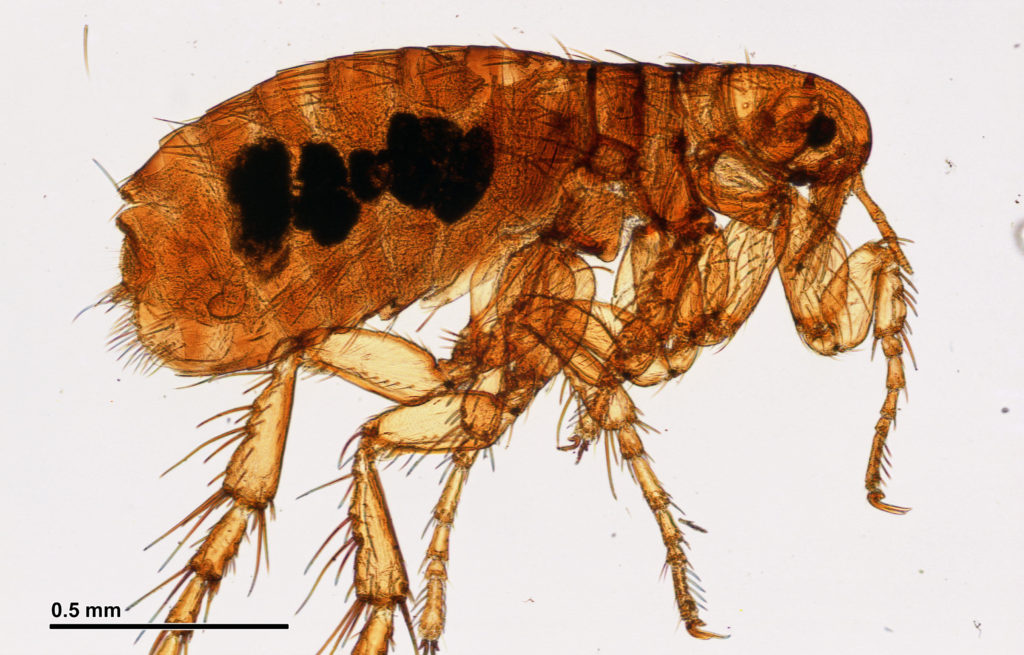Pet owners in Jasper, Georgia are likely very familiar with today’s insect of focus – fleas. Fleas are insect pests of humans and their domestic animals all over the world. While most fleas prefer non-human hosts, many can readily feed on humans when infestations are heavy or when other hosts are not available.

Fleas generally require rather warm (70-85 F) and humid (greater than 50% relative humidity) conditions to develop substantial infestations, either indoors or out. As such, flea problems seem to peak in the spring, summer, and fall seasons, when these environmental conditions are common in and out of doors. The larvae are particularly sensitive to temperature and moisture extremes, especially dryness. Unfortunately for those of us in the southeastern United States, our “flea season” can be year-round since our environment is often rather warm and humid.
Generally concentrated in pet resting areas outdoors, fleas have been known to cause infestations both in yards and inside of homes. With a narrow body designed to allow it to move easily between hairs in animal fur, the flea is also well suited to travel easily through carpeting and into very narrow areas, such as crevices and into folds of upholstery or even below flooring and into subflooring areas. Covered in backward facing spines, the flea can easily move forward through hairs or feathers. These same spines, however, make it difficult to remove the flea by scratching or shaking.
Flea eggs are frequently laid on the host animal, but may be laid by adult fleas that have fallen to the ground (eg into carpeting or on the host animal’s bed). Since flea eggs are not attached to the host, those laid on the host will fall off and eventually hatch on the ground, in nests or bedding, or in carpets, upholstery, or cracks in the floor.
Each female flea will lay a few eggs each day until she’s laid around 300. These eggs will hatch in two to seven days depending on temperature and humidity. Once hatched the flea larvae, which are small, active, maggot-like creatures, frequently become entwined with the carpet and resist the pull of a vacuum cleaner. Once mature, the flea larvae spin a cocoon for pupation, which becomes covered with grains of sand, lint, dust, or other debris from the ground, making it very well camouflaged. If temperatures are favorable (greater than 70° F), within about 10 days the adult flea develops within the cocoon – but the adult may not emerge immediately.
Many adult fleas emerge from the pupa within one to two weeks after the cocoon is formed, but some will remain in a pre-emerged state, from which they may not emerge for several months to a year later. Warmth and vibrations or mechanical signals (such as your animal’s paw actually stepping on the cocoon) will trigger emergence. This phenomenon helps to explain why vacationers, or people who move into a new home or apartment, are besieged with hungry fleas within several hours of returning home or moving in. Adult fleas are ready to feed and mate very soon after they emerge from the cocoon.
All of these traits taken together make it quite difficult to manage a flea infestation in your home. This is why it is important to contact your pest management professional as soon as you suspect you have an issue with fleas so that they can take a look, correctly identify the pest, and assist you in determining a method of action. If you do have a flea infestation, you want to get rid of them as soon as possible in order to prevent the potential spread of diseases and prolonged frustration for you and your pets.
If you think you have a problem with fleas. . . or any other pest. . . or simply have a question. . . call Faith Pest Control at 770-823-9202. We’ll be happy to speak with you any time.
Here’s to helping YOU live PEST FREE,
Erica
P.S. And be sure to ask about our FREE 58 Point Pest Analysis of your home or office!
